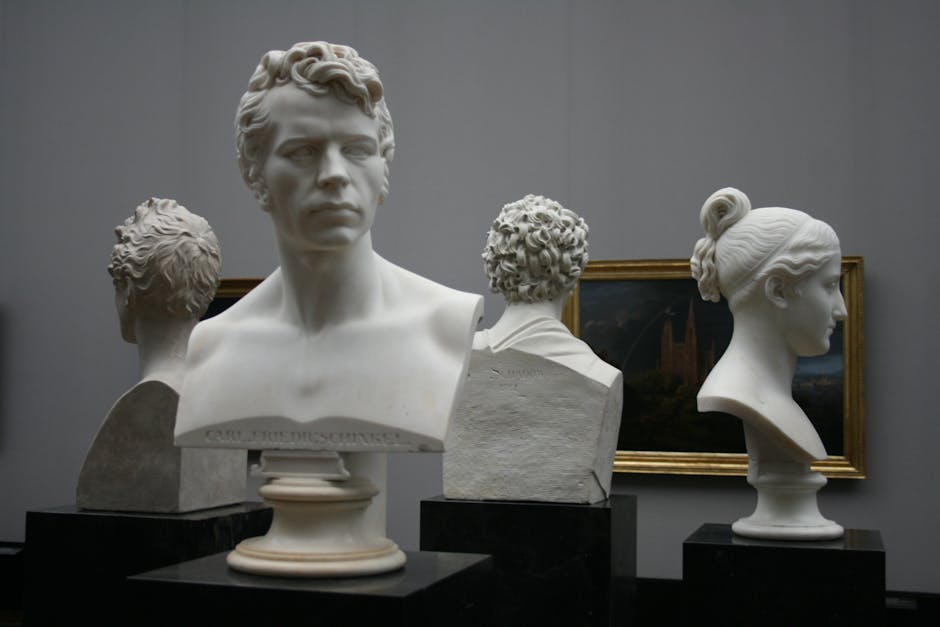Portraiture has evolved through time, reflecting the human experience in diverse ways. From classical depictions to modern expressions, each era has contributed to this enduring art form.
Classical Portraiture Foundations
Classical portraiture emerged during ancient Greece and Rome, setting a standard for artistic nobility. Artists like Phidias focused on gods and heroes, emphasizing divine symmetry and harmony. Perfectionism was key, with official portraits showcasing power and heroism.
These images weren't confined to elite spaces but appeared in public squares, establishing a visual literacy among the masses. The emphasis on balance, proportion, and an idealized approach to beauty became the foundation for later artistic movements.
The classical forms influenced Renaissance masters, who built upon this legacy of symmetry and idealism. Each era's contribution tells a story of human attributes cherished across time.

Renaissance to Grand Manner
The Renaissance brought a shift towards realism and naturalism. Artists like Leonardo da Vinci and Michelangelo infused their works with emotion and life-like detail. Da Vinci's "Mona Lisa" and Michelangelo's Sistine Chapel ceiling exemplify this era's mastery of technique and human insight.
In 18th-century Britain, the Grand Manner style elevated portraiture to fine art. Sir Joshua Reynolds championed this approach, drawing inspiration from classical art to capture power and dignity. Artists like Thomas Gainsborough and Thomas Lawrence further developed this style, creating compositions that immortalized their subjects with grace and sophistication.
This period bridged Renaissance vitality with majestic prestige, continuing the pursuit of capturing human essence through art.
Modern Art and Abstract Portraiture
Modern art brought a dramatic shift in portraiture, exploring human emotion and consciousness in new ways. Artists like Pablo Picasso and Frida Kahlo challenged traditional representations.
- Impressionists focused on capturing fleeting moments and the play of light.
- Cubism, led by Picasso, broke traditional perspectives, presenting subjects from multiple angles simultaneously.
- Abstract Expressionism embraced color and form to convey raw emotion.
Frida Kahlo's self-portraits delved into personal experiences and cultural commentary. These modern movements expanded portraiture beyond physical likeness, inviting deeper exploration of the human psyche and experience.
Contemporary Portraiture Innovations
Contemporary portraiture blends tradition with innovation. Artists like Kehinde Wiley and Amy Sherald combine classical techniques with modern themes, addressing current social issues.
Wiley's work often features young, black subjects in poses traditionally reserved for European aristocracy, making bold statements about identity and empowerment. Sherald's portraits, with their distinctive grayscale figures against vibrant backgrounds, invite reflection on race and representation.
New mediums and technologies are also shaping portraiture. Some artists use alternative materials like copper, while others incorporate digital elements such as augmented and virtual reality. These innovations offer fresh ways to engage viewers and expand the boundaries of portrait art.
Today's portraiture reflects our multifaceted world, continuing to explore human connection and identity through diverse artistic approaches.
Portraiture remains a powerful medium for capturing human essence, offering insights into both individual and shared experiences. As it evolves, it continues to bridge art and life, reflecting our ever-changing world.
- Reynolds J. Discourses on Art. London: Royal Academy of Arts; 1769-1790.
- Gould C. The Grand Manner: British Portraiture in the Eighteenth Century. London: National Portrait Gallery; 1976.
- Rothenstein J. British Art and the Modern Movement. London: Tate Gallery; 1962.
- Dorment R. Van Dyck: The English Portraits. The Telegraph. 2009.
- Cotter H. The Grand Manner: British Portraiture in the 18th Century. The New York Times. 1987.
- Holmes R. The Age of Wonder: How the Romantic Generation Discovered the Beauty and Terror of Science. New York: Pantheon Books; 2008.





















